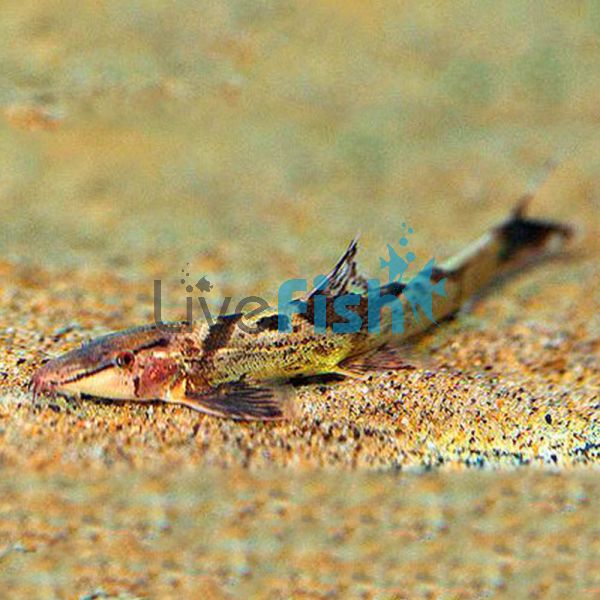Lizard Fish 7cm
Also known as the Saddleback Loach, Gecko Loach, or Orchid Loach.
The Lizard fish will be one of the oddball fish you will encounter in the aquarium hobby. They are not a common occurrence in the Australian aquarium hobby as well. This species is a member of the loach family and is the perfect camouflaged substrate scavenger which is why they will be a fun fish to keep. The semi-reclusive nature, wild colours, and unique body shape will be an eye-catcher for anyone aquarist or not. Lizard fish are surprisingly easy to care for and will make for a great addition in community settings but this species will look especially stunning in an Asian biotope with similar oddball fish.
- Buy 2 for $36.72 each and save 10%
- Buy 4 for $32.64 each and save 20%
Lizard Fish
The Lizard fish will be one of the oddball fish you will encounter in the aquarium hobby. They are not a common occurrence in the Australian aquarium hobby as well. This species is a member of the loach family and is the perfect camouflaged substrate scavenger which is why they will be a fun fish to keep. The semi-reclusive nature, wild colours, and unique body shape will be an eye-catcher for anyone aquarist or not. Lizard fish are surprisingly easy to care for and will make for a great addition in community settings but this species will look especially stunning in an Asian biotope with similar oddball fish.
Lizard fish go by many names such as saddleback loach or gecko loach and all of these titles suit the fish perfectly more or less. These fish have the aesthetic of a leaf-tailed gecko with their mottled pattern and earthy colours. On a sandy substrate with some gravel or botanicals, these fish will be almost invisible at first glance. The base colour of the lizard fish is a range of yellow shades which is contrasted by an array of dark brown striations and spots. These fish have especially elongated bodies with a narrow snout that is perfect for burrowing and sifting through the sand. They also do not have scales like most fish but more so very smooth skin, this adaptation allows them to effortlessly skim across the substrate whilst they search for food.
Lizard fish are incredibly social species and will love to be kept with members of their kind. Doing this will ensure that they are out in the open more and at less risk of being stressed. Breeding these fish in captivity has not been achieved yet and any individuals in the aquarium trade will be wild-caught. These fish most likely rely on multiple environmental factors to start breeding which may be difficult to replicate in the home aquarium. Males and females also do not have any dimorphic traits to them.
Tank Recommendations for your Lizard Fish
Lizard fish stay fairly small maxing out at around 10 cm which means they can be kept in smaller aquariums. Due to their social aspect and the need to be kept in a group, the best minimum tank volume would be 150 liters. This allows for a group of 5-6 loaches along with other tank mates if required. These fish come from fast-flowing rivers in the wild and it would be best to replicate an environment like this in the home aquarium.
Having a sandy substrate with larger grains of gravel and smooth river stones will offer a supernatural look. The use of driftwood and botanicals can also add to this aesthetic. Lizard fish however will thrive in most community fish settings with enough space. Though they are bottom-dwelling fish, it is also recommended to have a tight-fitting lid as these fish have a high risk of jumping out.
Suitable Tank Buddies
The lizard fish is an incredibly peaceful species that can be kept with almost any community fish. They have incredibly small mouths and would only have the risk of predating on shrimp.
Usually Compatible
Hillstream loach, bitterling, giant danio, Khuli loaches, chain loaches, and a range of other small community fish,
Sometimes Compatible
Territorial bottom-dwelling species like blue rams or Apistogramma may show minor but regular aggression to the lizard fish, posing a long-term risk.
Rarely Compatible
It is best to avoid any species which can attack, pester or prey on the lizard fish. These fish get stressed out very easily as it is but they also have pectoral spines. If they were to be swallowed, these spines will easily lodge in the predator's throat and will often kill them whilst often also resulting in the loach's death as well. Inverts like snails and shrimp will be demolished by the lizard fish as they are apt snail eaters.
Feeding your Lizard Fish
The lizard fish will be a very easy fish to feed once they settle into the aquarium. It is however best to start them on a frozen food diet with options like bloodworms as they settle into the aquarium. Once they are actively eating, they can be fed a quality sinking pellet moving forward. Lizard fish may also be nocturnal in their early days but giving them multiple small feeding throughout the day will get them more active during lighting hours. A fun feeding option would be to add some live black worms to the aquarium which promotes the loaches to naturally sift through the substrate to find their food.
| Scientific Name | Homaloptera Orthogoniata |
|---|---|
| Care Level | Moderate |
| Common Names | Lizard fish, Saddleback loach, Orchid Loach, Gecko Loach |
| Diet | Omnivore |
| Fish Family | Balitoridae |
| Lifespan (years) | 5 |
| Max. Length (cm) | 10 |
| Min. Tank Volume (l) | 150 Liters |
| Origin | Indonesia & Thailand |
| Reef Safe | Yes |
| Sociability | Peaceful |
| Venomous | No |
| Water Conditions | 24°-26° C, pH 6.0-7.0 |




